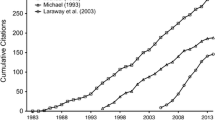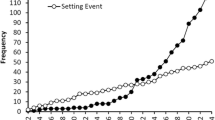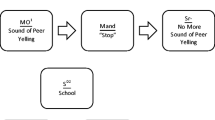Abstract
Motivating operations (MOs) exert a powerful influence over operant relations and hold significant implications for those working in applied settings. In this paper, we describe the concept of the MO and provide “real world” examples. Particular emphasis is given to the concept of the conditioned MO (CMO). Implications for intervention are discussed. It is hoped that this endeavour will encourage the utilization of the full conceptual system of the MO.
Similar content being viewed by others
References
Berg, W. K., Peck, S., Wacker, D. P., Harding, J., McComas, J., Richman, D., et al. (2000). The effects of presession exposure to attention on the results of assessments of attention as a reinforcer. Journal of Applied Behavior Analysis, 33, 463–477.
Brown, K. A., Wacker, D. P., Derby, K. M., Peck, S. M., Richman, D. M., Sasso, G. M., et al. (2000). Evaluating the effects of functional communication training in the presence and absence of establishing operations. Journal of Applied Behavior Analysis, 33, 53–71.
Call, N. A., Wacker, D. P., Ringdahl, J. E., & Boelter, E. W. (2005). Combined antecedent variables as motivating operations within functional analyses. Journal of Applied Behavior Analysis, 38, 385–389.
Carbone, V. J., Morgenstern, B., Zecchin-Tirri, G., & Kolberg, L. (2007). The role of the reflexive conditioned motivating operation (CMO-R) during discrete trial instruction of children with autism. Journal of Early and Intensive Behavior Intervention, 4, 658–679.
Carr, E. G., Newsom, C. D., & Binkoff, J. A. (1980). Escape as a factor in the aggressive behavior of two retarded children. Journal of Applied Behavior Analysis, 13, 101–117.
Dyer, K., Dunlap, G., & Winterling, V. (1990). Effects of choice-making on the serious problem behaviours of students with severe handicaps. Journal of Applied Behavior Analysis, 23, 515–524.
Ebanks, M. E., & Fisher, W. W. (2003). Altering the timing of academic prompts to treat destructive behavior maintained by escape. Journal of Applied Behavior Analysis, 36, 355–359.
Endicott, K., & Higbee, T. S. (2007). Contriving motivating operations to evoke mands for information in preschoolers with autism. Research in Autism Spectrum Disorders, 1, 210–217.
Fuller, P. R. (1949). Operant conditioning of a vegetative human organism. American Journal of Psychology, 62, 587–590.
Hall, G., & Sundberg, M. L. (1987). Teaching mands by manipulating conditioned establishing operations. The Analysis of Verbal Behavior, 5, 41–53.
Hart, B., & Risley, T. R. (1975). Incidental teaching of language in preschool. Journal of Applied Behavior Analysis, 8, 411–420.
Horner, R. H., Day, H. M., & Day, J. R. (1997). Using neutralizing routines to reduce problem behaviors. Journal of Applied Behavior Analysis, 30, 601–614.
Iwata, B. A., & Dozier, C. L. (2008). Clinical application of functional analysis methodology. Behavior Analysis in Practice, 1, 3–9.
Iwata, B. A., Vollmer, T. R., Zarcone, J. R., & Rodgers, T. A. (1993). Treatment classification and selection based on behavioral function. In R. V. Houton & S. Axelrod (Eds.), Behavior analysis and treatment (pp. 101–125): Kluwer Academic Publishers.
Keller, F. S., & Schoenfeld, W. N. (1950). Principles of psychology: A systematic text in the science of behavior. E. Norwalk: Appleton-Century Crofts.
Kennedy, C. H., & Meyer, K. A. (1998). Establishing operations and the motivation of challenging behavior. In L. Cameron (Ed.), Antecedent control: Innovative approaches to behavioral support (pp. 329–334). Baltimore: Paul H Brookes.
Lalli, J. S., Vollmer, T. R., Progar, P. R., Wright, C., Borrero, J., Daniel, D., et al. (1999). Competition between positive and negative reinforcement in the treatment of escape behavior. Journal of Applied Behavior Analysis, 32, 285–296.
Langthorne, P., McGill, P., & O’Reilly, M. F. (2007). Incorporating motivation into the functional analysis of challenging behavior: On the interactive and integrative potential of the motivating operation. Behavior Modification, 31, 466–487.
Laraway, S., Snycerski, S., Michael, J., & Poling, A. (2003). Motivating operations and some terms to describe them: Some further refinements. Journal of Applied Behavior Analysis, 36, 407–414.
McComas, J. J., Hoch, H., Paone, D., & El-Roy, D. (2000). Escape behavior during academic tasks: A preliminary analysis of idiosyncratic establishing operations. Journal of Applied Behavior Analysis, 33, 479–493.
McDevitt, M. A., & Fantino, E. (1993). Establishing operations and the discriminative stimulus. The Behavior Analyst, 16, 225–227.
McGill, P. (1999). Establishing operations: Implications for the assessment, treatment, and prevention of problem behavior. Journal of Applied Behavior Analysis, 32, 393–418.
Michael, J. (1982). Distinguishing between discriminative and motivational functions of stimuli. Journal of the Experimental Analysis of Behavior, 37, 149–155.
Michael, J. (1993). Establishing operations. The Behavior Analyst, 16, 191–206.
Michael, J. (2000). Implications and refinements of the establishing operation concept. Journal of Applied Behavior Analysis, 33, 401–410.
Michael, J. (2007). Motivating Operations. In J. O. Cooper, T. E. Heron & W. L. Heward (Eds.), Applied behavior analysis (2nd ed., pp. 374–391). NJ: Merrill Prentice Hall.
O’Reilly, M. F., Lancioni, G. E., King, L., Lally, G., & Dhomhnaill, O. N. (2000). Using brief assessments to evaluate aberrant behavior maintained by attention. Journal of Applied Behavior Analysis, 33, 109–112.
Pace, G. M., Iwata, B. A., Cowdery, G. E., Andree, P. J., & McIntyre, T. (1993). Stimulus (instructional) fading during extinction of self-injurious escape behavior. Journal of Applied Behavior Analysis, 26, 205–212.
Skinner, B. F. (1953). Science and human behavior. New York: MacMillan.
Smith, R. G., & Iwata, B. A. (1997). Antecedent influences on behavior disorders. Journal of Applied Behavior Analysis, 30, 343–375.
Smith, R. G., Iwata, B. A., Goh, H. L., & Shore, B. A. (1995). Analysis of establishing operations for self-injury maintained by escape. Journal Of Applied Behavior Analysis, 28, 515–535.
Sundberg, M. L. (1993). The application of establishing operations. The Behavior Analyst, 16, 211–214.
Sundberg, M. L. (2004). A behavioral analysis of motivation and its relation to mand training. In L. W. Williams (Ed.), Developmental disabilities: Etiology, assessment, intervention and integration (pp. 199–220). Reno, NV: Context Press.
Sundberg, M. L., Loeb, M., Hale, L., & Eigenheer, P. (2002). Contriving establishing operations to teach mands for information. The Analysis of Verbal Behavior, 18, 15–29.
Taylor, B. A., & Hoch, H. (2008). Teaching children with autism to respond to and initiate bids for joint attention. Journal of Applied Behavior Analysis, 41, 377–391.
Tiger, J. H., Hanley, G., & Bruzek, J. (2008). Functional communication training: A review and practical guide. Behavior Analysis in Practice, 1, 16–23.
Author information
Authors and Affiliations
Additional information
The paper contributed towards the first author’s doctoral dissertation.
Rights and permissions
About this article
Cite this article
Langthorne, P., McGill, P. A Tutorial on the Concept of the Motivating Operation and its Importance to Application. Behav Analysis Practice 2, 22–31 (2009). https://doi.org/10.1007/BF03391745
Published:
Issue Date:
DOI: https://doi.org/10.1007/BF03391745




